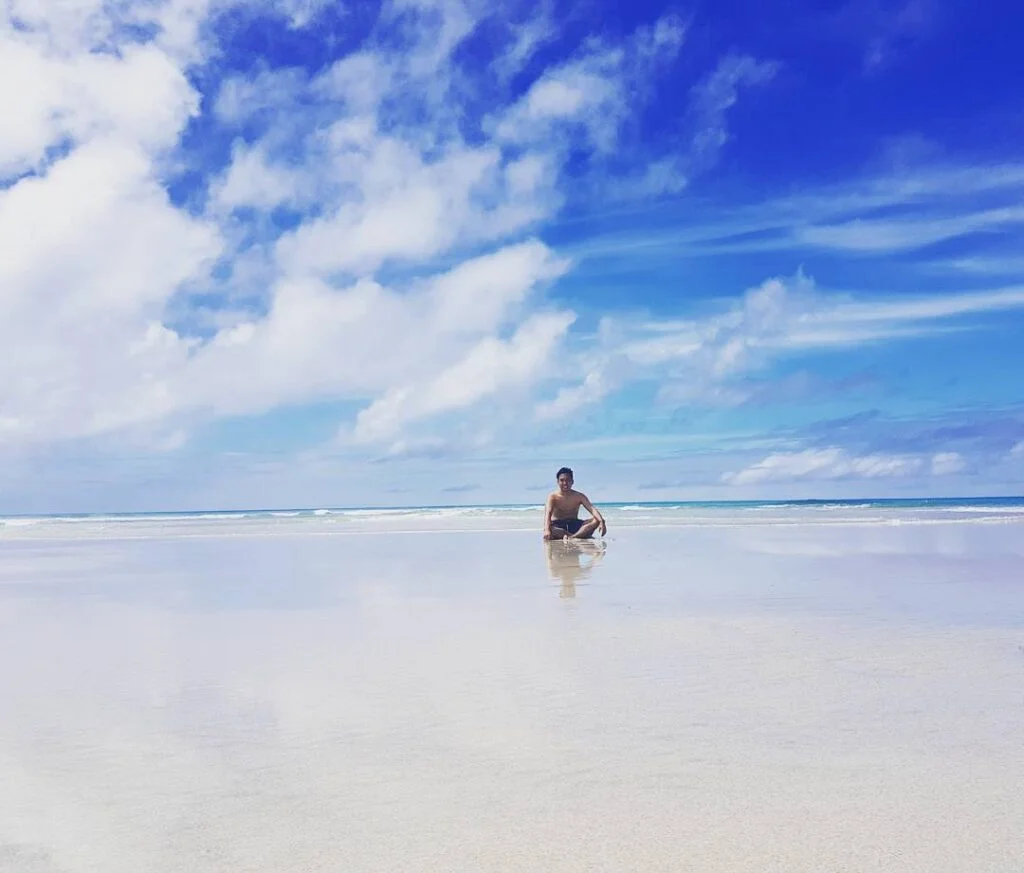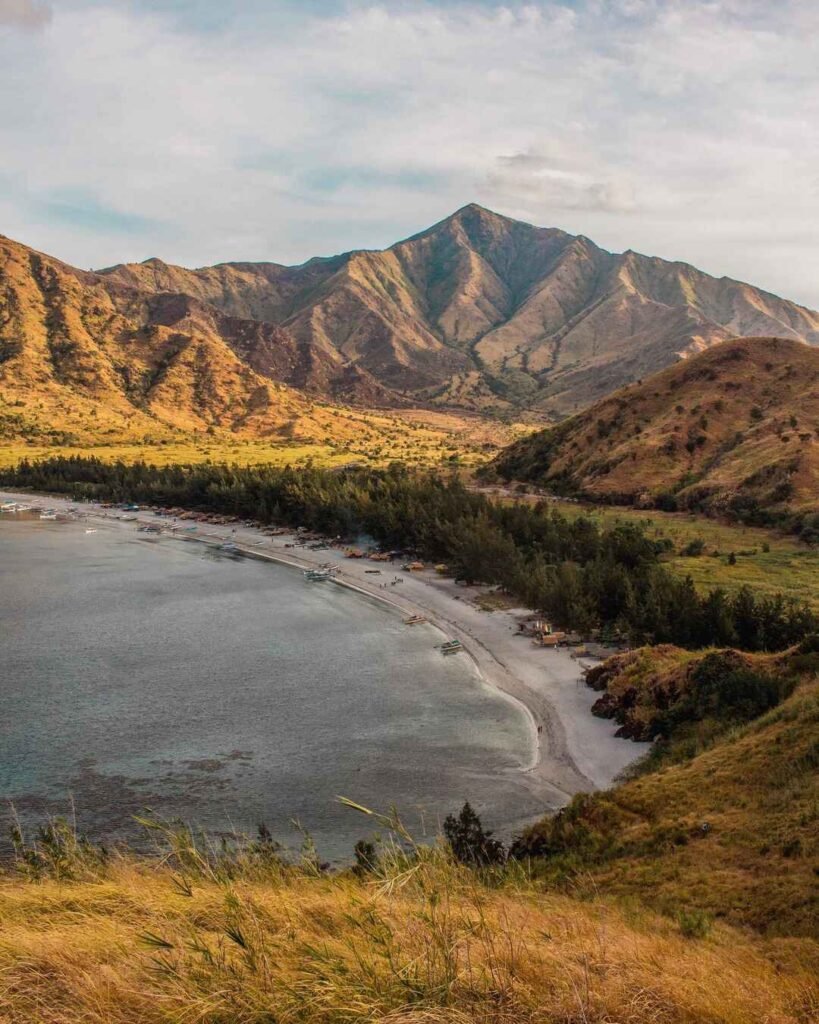
Introduction: Why Visit Dinagat Island?
The Mystical “Last Frontier”
When I first set foot on Dinagat Island, I understood why seasoned travelers whisper about it like a secret. Towering limestone walls guard turquoise coves; fishing villages move at a peaceful rhythm; and a quiet mysticism lingers in the air. Unlike overrun beach towns, the Dinagat Islands feel purposefully remote—close enough for a weekend adventure, yet far enough to keep the crowds at bay. That remoteness isn’t a hassle; it’s the promise. Here, sunrise can still belong to you alone.
Where Is Dinagat Island Located?
Readers often ask, “where is Dinagat Island located?” Picture the northeastern corner of Mindanao, where the Philippine Sea meets the Surigao Strait. The province is a compact archipelago with San Jose as the main hub, reached by a short ferry from Surigao City. That final sea crossing is part of the charm: it filters out casual day-trippers and rewards intent—ideal for travelers who value solitude, authenticity, and nature that still feels raw.
Not Siargao or Palawan—Its Own Soul
It’s tempting to compare Dinagat Island to Palawan’s karst landscapes or Siargao’s surf culture, but this place stands on its own. Think Coron-like lagoons without the tour queues; pocket beaches as pristine as any in the country; and a cultural layer shaped by unique local history and faith. I personally recommend starting with the Libjo loop for dramatic rock formations and the Basilisa circuit for beaches and the trek to Lake Bababu—both reveal Dinagat’s personality beyond familiar labels.
Quick Tips Before You Go
Best first step: Fly to Butuan or Surigao, then ferry to San Jose (early boats = fewer people and calmer seas).
Budget hack: Split a private island-hopping boat with other travelers you meet on the ferry or at your lodge.
Pack smart: Dry bag, reef-safe sunscreen, sturdy sandals—many landings are rocky.
Cash is king: ATMs are scarce; bring enough for tours, meals, and guide fees.
Come for the karst silhouettes and emerald pools; stay for the hush of islands that still feel undiscovered. Dinagat Island rewards patience with experiences you won’t find on a packaged route—and that’s exactly the point.
Table of Contents
Whispers of the Past: Dinagat Island History & Culture
Sacred Beginnings in Pre-Colonial Times
Long before maps marked its place, the Dinagat Islands were already etched into legend. Ancient folklore speaks of Dinagat as sacred ground, where Da—the God of Peace—convinced the God of Hurricanes to spare the islands. This myth cemented its reputation as a mystical sanctuary, a perception that continues to shape how locals see their homeland today. For travelers seeking more than just beaches, this layer of spirituality adds depth to the Dinagat Island history—a reminder that you are stepping onto land once regarded as a holy refuge.
Spanish Influence and Visayan Migration
The colonial period introduced new layers to the islands’ identity. In 1855, the municipality of Dinagat was formally established, and migrants from nearby Bohol and Leyte began to settle here. Over time, this migration wove Cebuano and Waray-Waray languages into the local culture, giving the province its distinct linguistic flavor. Today, when you hear locals seamlessly switch between dialects, you are listening to a living record of centuries of cultural blending.
A Turning Point in World War II
Dinagat’s significance wasn’t confined to legend and colonial history—it also played a pivotal role in World War II. On October 17, 1944, U.S. forces made their historic landing on the shores of Loreto. Known as “Black Beach No. 2,” this marked the first time the American flag was raised again on Philippine soil after the Japanese invasion. Standing on that shoreline today, it’s humbling to realize the global importance of this small province. Remnants of shipwrecks and wartime relics off Basilisa still whisper of that era, turning a casual dive into a history lesson beneath the waves.
The PBMA Legacy and Modern Identity
Fast forward to the modern era, and the identity of Dinagat Island Surigao del Norte is inseparable from the Philippine Benevolent Missionaries Association (PBMA). Founded in the 1960s by Ruben Ecleo Sr., the PBMA shaped both the spiritual and political life of the province. Revered by followers as the “Divine Master,” Ecleo’s influence built not just a movement but also a dynasty. His legacy lives on in surreal landmarks: the PBMA Shrine, his mausoleum, and the castle-like residence of the Ecleo family.
When I explored San Jose, these structures stood out immediately. They rise unexpectedly amid a quiet provincial town, serving as symbols of faith, controversy, and identity. What struck me most, however, was not their scale but the sense of order in daily life. Police officers and locals alike describe Dinagat as unusually peaceful, a testament to the unique social fabric PBMA left behind.
Visiting Dinagat is not only about beaches and lagoons—it is also about walking through a living narrative where myth, colonial legacies, wartime heroics, and modern faith converge. To understand the islands is to embrace their history, a story that gives every journey here a deeper resonance.

Planning Your Expedition: Practical Travel Guide
Best Time to Visit Dinagat Island
Choosing the best time to visit Dinagat Island can make or break your experience. The dry season, from January to April, offers the most reliable weather for boat transfers and island-hopping tours. March is often cited as the sweet spot: the seas are calm, skies are clear, and both the Basilisa and Libjo circuits can usually be explored without interruption.
While the islands remain accessible year-round, the wet season between November and January can pose challenges. Stronger monsoon winds and occasional typhoons may lead to ferry cancellations, rough seas, and reduced visibility for snorkeling or diving. I personally recommend avoiding this window unless you have a flexible schedule. If you want the best combination of affordability and good conditions, plan for late February or early March—you’ll enjoy vibrant weather while steering clear of peak Holy Week crowds.
How to Get to Dinagat Island
Many travelers ask me, “How to get to Dinagat Island if there’s no airport?” The answer: all journeys funnel through Surigao City, with the final leg by sea.
By Air
From Manila to Surigao: No direct flights currently exist, so you’ll need a connecting flight via Cebu or Butuan. Travel time ranges from 3–4 hours, with Cebu Pacific and PAL as main carriers.
From Cebu to Dinagat Island: The simplest route is a direct Cebu–Surigao flight on Cebgo (around 55 minutes). This is my preferred option since it saves a day compared to Manila routes.
Via Butuan Airport: Often cheaper, but you’ll need a 2–4 hour van or bus ride to Surigao City before boarding the ferry.
Land Transfer to Surigao Port
From Surigao Airport, it’s only 15 minutes by tricycle to the pier (₱30–₱50).
From Butuan, vans to Surigao cost ₱200–₱460 depending on class.
Ferry Schedule to Dinagat Island
From Surigao Port (Pantalan Dos), multiple boats serve San Jose daily.
Montenegro Shipping (RORO/Fast Craft): 2.5 hrs, ₱170–₱255, twice daily.
Evaristo & Sons: 1.5 hrs, ₱150–₱200, early morning and late morning.
Vince Gabriel Liner: 1 hr, ~₱200, early afternoon.
Pumpboats (Lantsa): 1.5–2 hrs, ~₱200, first trip around 5:30 AM.
Pro tip: Always aim for morning departures. Afternoon sailings are fewer, and missing the last trip means an unplanned night in Surigao.
Getting Around Dinagat
Once you land in San Jose, transport feels both quirky and local. The most common option is the bao-bao, a three-wheeled vehicle similar to a tuk-tuk, used for town transfers and short scenic tours. For more rugged trips, especially in remote barangays, you’ll need a habal-habal (motorcycle taxi).
Short town trips: ₱10–₱35 per person.
Chartered day tour with bao-bao driver: ~₱500 in San Jose.
Extended tours (e.g., Cagdianao side): ₱1,500 or more.
Unlike Siargao, motorbike rentals are rare, so pre-arranging with local drivers is the best strategy. From my experience, negotiating politely and confirming rates before departure avoids surprises.
Where to Stay in Dinagat Island
Accommodation in Dinagat reflects its untouched vibe: simple, functional, and refreshingly affordable. Most options cluster in San Jose, which doubles as the transportation hub for island-hopping.
Budget Homestays and Lodges
Rose Pink Lodge – Rooms start at ₱500, clean and welcoming.
Come & Lodge @ Sofia’s Bed – Around ₱800/night, good for air-conditioned comfort.
Happy Nest Hostel – A backpacker-friendly choice with communal spaces.
Mid-Range Inns & Packages
Some inns double as tour providers. Jmalls Island Tourist Inn is popular for bundling stays with boat tours, making it hassle-free for first-time visitors.
Higher-End or Unique Stays
If you’re looking for something above the usual, Vines B&B in San Jose delivers hotel-like quality with polished amenities. Meanwhile, private rentals in Basilisa (like “Private Island Escape”) cater to those seeking exclusivity.
When I stayed at Vines B&B, I found it surprisingly refined for such a remote province—it felt like a hidden boutique gem. For most travelers, though, budget homestays remain the best way to connect with locals.
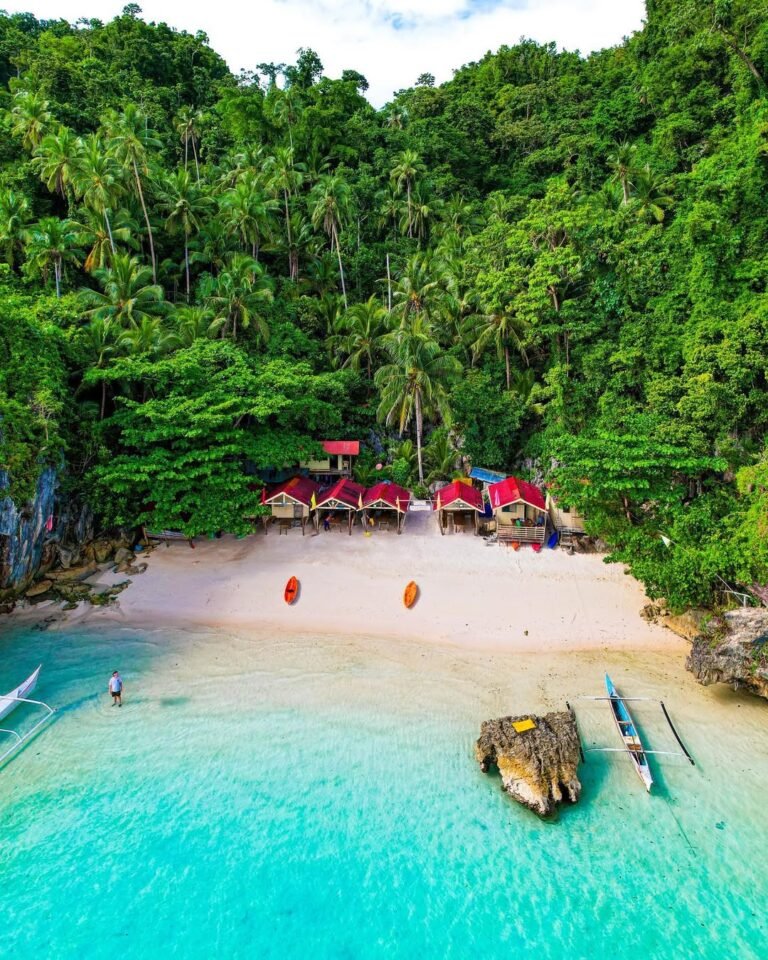
The Crown Jewels: Top Dinagat Island Tourist Spots
The Basilisa Circuit: Lakes, Beaches, and Hidden Coves
If you’re looking for the most iconic Dinagat Island tourist spot, the Basilisa Circuit should be at the top of your list. This route, usually covered in a full-day island-hopping trip, combines dramatic landscapes with cultural lore and a touch of adventure.
Lake Bababu
The heart of Basilisa is the enigmatic Lake Bababu. To reach it, you’ll trek for about 30–45 minutes through rocky limestone terrain—a route that demands sturdy sandals and a good dry bag for your gear. The lake itself is a natural wonder, a meromictic body where fresh rainwater floats above denser saltwater. Local guides often share its spiritual significance, especially among PBMA members who once considered it a site of healing. What makes it even more fascinating is its 650-meter underwater cave connection to the sea—the longest of its kind in the Philippines. Taking a dip here after the trek feels both refreshing and otherworldly.
Bitaog Beach
Next is Bitaog Beach, a postcard-perfect cove framed by towering limestone cliffs. Its powdery white sand and crystal-clear water make it ideal for swimming and photography. This is one of those things to do in Dinagat Island that feels like stepping onto your own private beach, especially if you arrive early in the day before other groups.
Duyos Beach
A short hop away, Duyos Beach offers a different kind of magic. A tidal sandbar emerges at low tide, creating a shifting landscape perfect for photos and leisurely walks. Standing on the sandbar with turquoise waters stretching in both directions is a surreal experience I still remember vividly.
Pagkawasan Garden Resort & Cabacungan Cove
For a balance of comfort and nature, Pagkawasan Garden Resort offers manicured grounds and a grotto built by locals. Meanwhile, Cabacungan Cove remains largely untouched, a quieter escape where limestone walls shelter a crescent of sand.
Traveler’s Tip: Pack snacks and water before leaving San Jose, as food options are limited on these islands. A dry bag and aqua shoes will make the trek to Lake Bababu much easier and safer.
The Libjo Loop: Lagoons, Rocks, and Hidden Pools
If Basilisa is about coves and treks, the Libjo Loop showcases the dramatic geology that makes the Dinagat Islands so captivating. I always recommend pairing both circuits if you have time, but if you can only choose one, Libjo will impress you with its raw scenery.
Blue Lagoon Dinagat Island
The undeniable star of Libjo is the Blue Lagoon. From above, its waters shift from pale turquoise to deep emerald, thanks to a sudden drop-off into a submerged cavern. A carved limestone viewpoint offers one of the best panoramas in the province. I still remember standing on that ledge, camera in hand, trying to capture what no photo could fully translate—the sense of depth and serenity. This spot alone justifies the trip and is among the most Instagrammable locations in Mindanao.
Hagakhak Rock Formations
Further along, the Hagakhak Rock Formations rise dramatically from the sea. Their layered, jagged patterns echo the famous Biri Rocks of Northern Samar but without the crowds. Cruising close by boat is impressive enough, but if the tide allows, ask your boatman to dock for a short walk among the rocks—it’s like stepping into a natural sculpture garden.
Jelmar’s Islet Resort
Nicknamed the “Maldives of Dinagat,” Jelmar’s Islet Resort is a charming stop for lunch or even an overnight stay in rustic cottages. The water clarity here is extraordinary—on my last trip, I could see corals and fish from the boat deck without even diving in. For travelers craving comfort during island-hopping, this is a refreshing midway point.
Pangabangan Island & Miracle Pool
Finally, Pangabangan Island offers a more classic tropical vibe with healthy reefs for snorkeling. Nearby, the Miracle Pool—an underground cave pool—invites travelers for a refreshing swim. It’s dimly lit, cool, and peaceful, making it feel like a secret oasis.
Local Hack: Ask your boatman to time Blue Lagoon and Hagakhak stops early in the morning or late in the afternoon. Not only will you avoid the harsh midday light for photos, but you’re also more likely to have these natural wonders all to yourself.
The Remote Cagdianao Coast
For those who crave solitude, the eastern coast in Cagdianao delivers a different vibe altogether. Hinabyan Beach stretches long and quiet, its powdery sand practically untouched. Sayaw Island, just off the coast, offers another pristine stop rarely included in standard tours. This is where I suggest spending an extra day if you’re after a true “digital detox.” With minimal infrastructure and few visitors, it feels like discovering your own castaway retreat—a reminder that not every Dinagat Island tourist spot is about grandeur. Sometimes, it’s the simplicity of an empty beach that stays with you the longest.
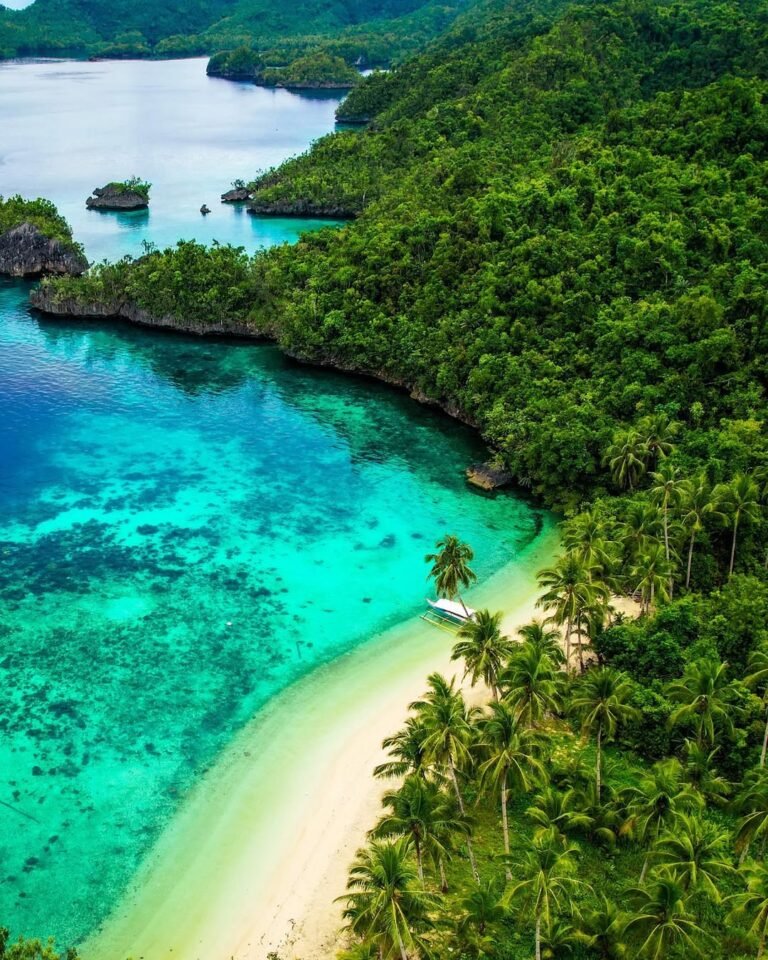
Crafting Your Adventure: Tours & Itineraries
Tour Options: Choosing the Best Way to Explore
When planning things to do in Dinagat Island, the most important decision you’ll make is how to structure your island-hopping. Two main approaches exist: chartering a private boat or joining a package tour.
Private Boat Charter
This is the most flexible option and perfect for small groups or travelers who like to set their own pace. For around ₱3,000–₱3,500 per day, you can charter a boat that fits 4–8 people, covering either the Basilisa Circuit or the Libjo Loop. With this setup, you decide how long to linger at Lake Bababu or whether to squeeze in a sunset at Bitaog Beach. The costs are per boat, so if you find fellow travelers on the ferry, it’s easy to split expenses.
Package Tours
If convenience is your priority, package tours are available through San Jose-based operators like Jmalls Island Tourist Inn and Azonta Travel & Tours. For about ₱3,000–₱3,500 per person, you’ll typically get a 2D1N package that covers accommodation, meals, boat tours, a guide, and most entrance fees. Extended packages (e.g., 4D3N for ~₱7,200) let you see both circuits at a comfortable pace.
Personal Tip: On my last visit, I tried both—chartering for flexibility one day, then joining a package the next. For first-timers, a package is stress-free, but if you want unique photos and quieter beaches, private charters let you beat the crowds.
Sample Itineraries: From Quick Escapes to Deep Dives
To help you visualize your trip, here are two sample itineraries with a practical budget breakdown for Dinagat Island. These cover essentials like transport, lodging, and entrance fees.
3-Day Weekend Escape
Perfect for travelers with limited time who want a taste of San Jose and one full island-hopping circuit.
Day 1: Morning ferry from Surigao → Check-in at San Jose lodge → Afternoon land tour (PBMA Shrine, Islander’s Castle, public market).
Day 2: Full-day Basilisa Circuit. Trek to Lake Bababu, swim at Bitaog and Duyos Beaches, and unwind at Pagkawasan Garden Resort.
Day 3: Early breakfast, then ferry back to Surigao.
5-Day Deep Dive
Best for travelers who want to experience both circuits and still have downtime.
Day 1: Arrival in San Jose, relax and explore the town.
Day 2: Libjo Loop highlights—Blue Lagoon, Hagakhak Rocks, Jelmar’s Islet, Pangabangan Island.
Day 3: Basilisa Circuit—Lake Bababu trek, Bitaog Beach, Duyos sandbar, Cabacungan Cove.
Day 4: Land tour of San Jose and Cagdianao coast (Hinabyan Beach, Sayaw Island).
Day 5: Ferry return to Surigao.
Budget Breakdown for Dinagat Island (Approx. per person, 3-Day Trip, Group of 4)
| Category | Item | Cost (PHP) | Notes |
|---|---|---|---|
| Accommodation | 2 nights in budget lodge | 800 | ₱400/person/night |
| Transportation | Roundtrip Surigao–San Jose ferry | 400 | ₱200 each way |
| Local Transport | Bao-bao + tricycles | 200 | Port + town transfers |
| Tours | 1-day private boat charter | 875 | ₱3,500/4 pax |
| Land Tour | Bao-bao charter | 125 | ₱500/4 pax |
| Guide Fee | Lake Bababu trek | 75 | ₱300/4 pax |
| Food & Drinks | Local meals (3 days) | 2,400 | ₱800/day |
| Entrance Fees | Beaches & Lake Bababu | 125 | Avg. ₱20–₱50 each |
| Contingency | 10% buffer | 500 | For extras |
| Estimated Total | — | 5,500 | Excluding flights |
Traveler’s Note: These figures reflect real costs as of 2025. If you’re on a tighter budget, join a package tour to avoid per-boat expenses. But if you value independence, splitting a private boat with new friends you meet on the ferry is the best hack.
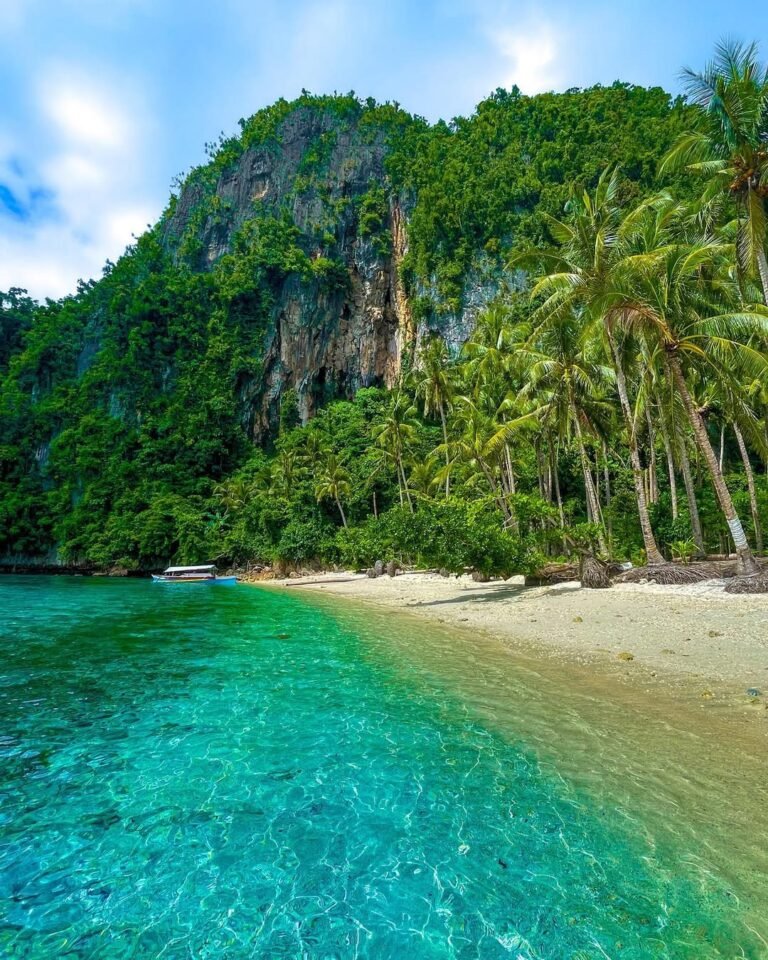
A Taste of Dinagat: Culinary Scene
Fresh from the Sea
One of the most memorable things to do in Dinagat Island is to indulge in its simple yet outstanding food culture. Here, the day’s catch sets the menu. Fish, squid, crabs, and shellfish are sold straight from fishing boats to the market in San Jose, often grilled or served raw within hours.
Kinilaw is the undisputed star. I had the best kinilaw by the port—fresh tuna diced and cured in calamansi, vinegar, ginger, and chili. It was zesty, refreshing, and the kind of dish that proves freshness is everything. Another staple is sinugba—grilled fish or squid over charcoal, usually enjoyed with rice and soy-vinegar dip. For groups, the boodle fight is a must: grilled seafood, noodles, and fruits laid on banana leaves and eaten with bare hands.
Unique Local Flavors
Dinagat also offers something unusual—poot-poot ginamos, a fermented fish sauce made from tiny native fish. Salty, pungent, and addictive, it’s a common pasalubong (take-home gift) and a flavor that locals swear by.
Where to Eat
Don’t expect fancy restaurants; instead, seek out small eateries and carinderias in San Jose. Solomon Eatery and Denor Restaurant are two reliable options for home-style Filipino meals. For the most authentic experience, buy seafood at the market and ask locals to grill it on the spot—an experience that combines food with genuine island hospitality.
Essential Know-How & Travel Tips
Money Matters
Cash is non-negotiable in Dinagat. ATMs are extremely limited, and card payments are almost unheard of outside San Jose. Bring enough pesos to cover lodging, boat tours, entrance fees, and food. I usually set aside extra for emergencies since even ATMs can run out of cash.
Connectivity
Signal here is patchy at best. Globe users often struggle, while Smart sometimes works in town centers. Internet access usually comes through Piso-WiFi hotspots in populated areas, where ₱1 buys 10–15 minutes. My hack: download offline maps and confirm all bookings before arrival.
Packing Essentials
Dry bag: Protect phones and cameras during boat rides.
Sturdy sandals or aqua shoes: Lake Bababu’s trail can be sharp and slippery.
Power bank: Power outages still happen in remote barangays.
Snacks & water: Few stores operate on the smaller islands.
Safety and Comfort
While broader Mindanao sometimes raises caution, the Dinagat Island tourist spot experience is generally safe. Locals are warm, and crime is almost nonexistent. Still, avoid joining large political gatherings and always check ferry schedules in case of weather disruptions. If traveling solo, I found it reassuring that drivers and guides here often know each other—everyone looks out for visitors.
Final Reflections: Why Dinagat Island is the Mystical Last Frontier
After days of exploring, I realized that Dinagat Island is not simply another off-the-beaten-path stop—it is a living, breathing story of remoteness, resilience, and quiet wonder. From the mystical trek to Lake Bababu to the shifting sands of Duyos Beach, every corner whispers of a place still unshaped by mass tourism.
What struck me most was the harmony between its dramatic landscapes and its people. The PBMA landmarks in San Jose speak of a unique cultural identity, while the untouched beaches and lagoons remind travelers why this is called the country’s “mystical last frontier.”
To experience the Dinagat Islands is to embrace patience and simplicity. It demands planning, from ferry schedules to cash reserves, but rewards with solitude you won’t find in Palawan or Siargao. I left feeling like I had stepped into a secret paradise—one that asks you to slow down, listen, and respect its delicate balance.
As visitors, our role is to travel responsibly: support local guides and carinderias, minimize plastic use, and leave no trace on trails and beaches. Only then can Dinagat remain a sanctuary, not just for us but for future generations seeking mystery in a world that feels increasingly mapped.
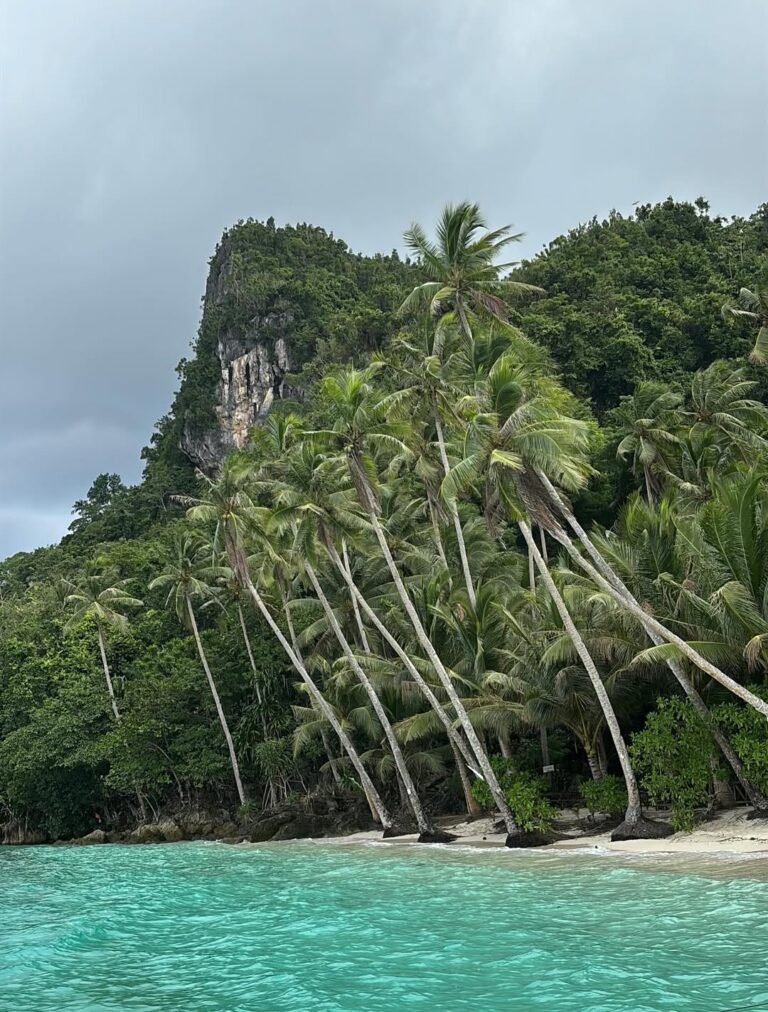
FAQ: Dinagat Island Travel Guide
Where is Dinagat Island located?
Dinagat Island is in the northeastern part of Mindanao, Philippines, across the Surigao Strait, with San Jose as its capital and main entry point.
What is the best time to visit Dinagat Island?
The best time to visit Dinagat Island is during the dry season, from January to April, with March offering the calmest seas and clearest skies.
How do I get to Dinagat Island?
Take a flight to Surigao or Butuan, then travel to Surigao Port. From there, ferries and pumpboats run daily to San Jose, the provincial capital.
What are the top things to do in Dinagat Island?
Must-see attractions include Lake Bababu, Blue Lagoon, Bitaog Beach, Duyos Beach sandbar, Hagakhak Rock Formations, and Pangabangan Island.
Where to stay in Dinagat Island?
Most accommodations are in San Jose. Options range from budget lodges like Rose Pink Lodge to mid-range inns and higher-end stays like Vines B&B.
How much should I budget for a trip to Dinagat Island?
A 3-day trip costs around ₱5,500 per person (excluding flights), covering ferry rides, lodging, food, entrance fees, and a private boat tour split among 4.

